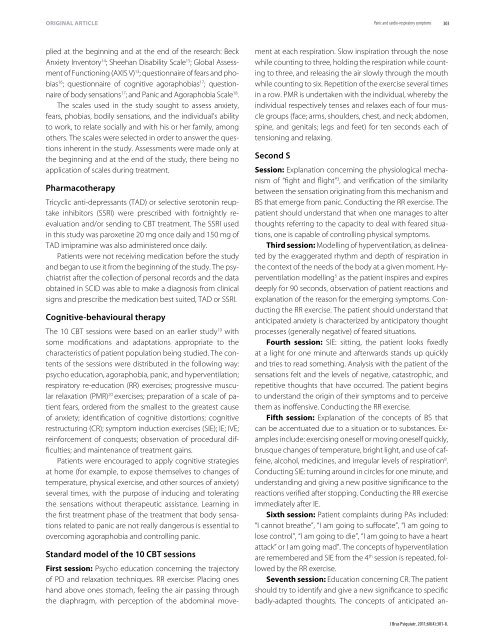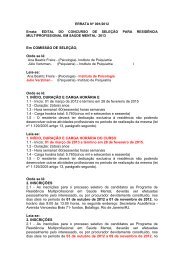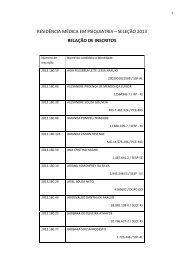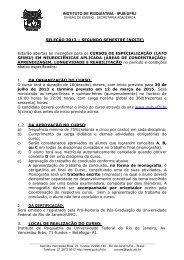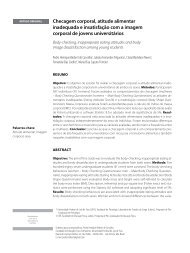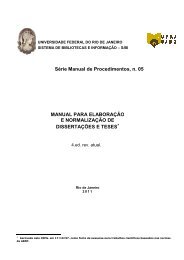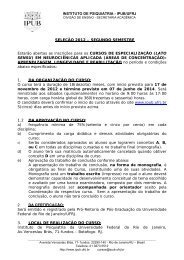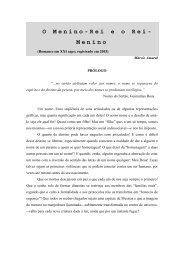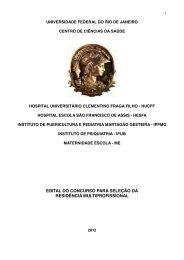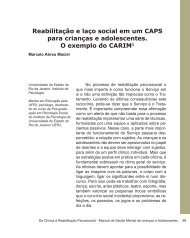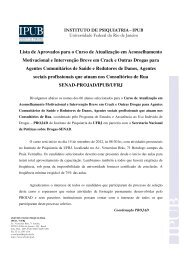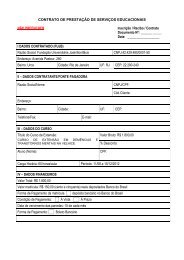Originais â Originals outubro | dezembro ⢠2011 - IPUB - UFRJ
Originais â Originals outubro | dezembro ⢠2011 - IPUB - UFRJ
Originais â Originals outubro | dezembro ⢠2011 - IPUB - UFRJ
You also want an ePaper? Increase the reach of your titles
YUMPU automatically turns print PDFs into web optimized ePapers that Google loves.
ORIGINAL ARTICLE<br />
Panic and cardio-respiratory symptoms<br />
303<br />
plied at the beginning and at the end of the research: Beck<br />
Anxiety Inventory 14 ; Sheehan Disability Scale 15 ; Global Assessment<br />
of Functioning (AXIS V) 13 ; questionnaire of fears and phobias<br />
16 ; questionnaire of cognitive agoraphobias 17 ; questionnaire<br />
of body sensations 17 ; and Panic and Agoraphobia Scale 18 .<br />
The scales used in the study sought to assess anxiety,<br />
fears, phobias, bodily sensations, and the individual’s ability<br />
to work, to relate socially and with his or her family, among<br />
others. The scales were selected in order to answer the questions<br />
inherent in the study. Assessments were made only at<br />
the beginning and at the end of the study, there being no<br />
application of scales during treatment.<br />
Pharmacotherapy<br />
Tricyclic anti-depressants (TAD) or selective serotonin reuptake<br />
inhibitors (SSRI) were prescribed with fortnightly reevaluation<br />
and/or sending to CBT treatment. The SSRI used<br />
in this study was paroxetine 20 mg once daily and 150 mg of<br />
TAD imipramine was also administered once daily.<br />
Patients were not receiving medication before the study<br />
and began to use it from the beginning of the study. The psychiatrist<br />
after the collection of personal records and the data<br />
obtained in SCID was able to make a diagnosis from clinical<br />
signs and prescribe the medication best suited, TAD or SSRI.<br />
Cognitive-behavioural therapy<br />
The 10 CBT sessions were based on an earlier study 19 with<br />
some modifications and adaptations appropriate to the<br />
characteristics of patient population being studied. The contents<br />
of the sessions were distributed in the following way:<br />
psycho education, agoraphobia, panic, and hyperventilation;<br />
respiratory re-education (RR) exercises; progressive muscular<br />
relaxation (PMR) 20 exercises; preparation of a scale of patient<br />
fears, ordered from the smallest to the greatest cause<br />
of anxiety; identification of cognitive distortions; cognitive<br />
restructuring (CR); symptom induction exercises (SIE); IE; IVE;<br />
reinforcement of conquests; observation of procedural difficulties;<br />
and maintenance of treatment gains.<br />
Patients were encouraged to apply cognitive strategies<br />
at home (for example, to expose themselves to changes of<br />
temperature, physical exercise, and other sources of anxiety)<br />
several times, with the purpose of inducing and tolerating<br />
the sensations without therapeutic assistance. Learning in<br />
the first treatment phase of the treatment that body sensations<br />
related to panic are not really dangerous is essential to<br />
overcoming agoraphobia and controlling panic.<br />
Standard model of the 10 CBT sessions<br />
First session: Psycho education concerning the trajectory<br />
of PD and relaxation techniques. RR exercise: Placing ones<br />
hand above ones stomach, feeling the air passing through<br />
the diaphragm, with perception of the abdominal movement<br />
at each respiration. Slow inspiration through the nose<br />
while counting to three, holding the respiration while counting<br />
to three, and releasing the air slowly through the mouth<br />
while counting to six. Repetition of the exercise several times<br />
in a row. PMR is undertaken with the individual, whereby the<br />
individual respectively tenses and relaxes each of four muscle<br />
groups (face; arms, shoulders, chest, and neck; abdomen,<br />
spine, and genitals; legs and feet) for ten seconds each of<br />
tensioning and relaxing.<br />
Second S<br />
Session: Explanation concerning the physiological mechanism<br />
of “fight and flight” 3 , and verification of the similarity<br />
between the sensation originating from this mechanism and<br />
BS that emerge from panic. Conducting the RR exercise. The<br />
patient should understand that when one manages to alter<br />
thoughts referring to the capacity to deal with feared situations,<br />
one is capable of controlling physical symptoms.<br />
Third session: Modelling of hyperventilation, as delineated<br />
by the exaggerated rhythm and depth of respiration in<br />
the context of the needs of the body at a given moment. Hyperventilation<br />
modelling 5 as the patient inspires and expires<br />
deeply for 90 seconds, observation of patient reactions and<br />
explanation of the reason for the emerging symptoms. Conducting<br />
the RR exercise. The patient should understand that<br />
anticipated anxiety is characterized by anticipatory thought<br />
processes (generally negative) of feared situations.<br />
Fourth session: SIE: sitting, the patient looks fixedly<br />
at a light for one minute and afterwards stands up quickly<br />
and tries to read something. Analysis with the patient of the<br />
sensations felt and the levels of negative, catastrophic, and<br />
repetitive thoughts that have occurred. The patient begins<br />
to understand the origin of their symptoms and to perceive<br />
them as inoffensive. Conducting the RR exercise.<br />
Fifth session: Explanation of the concepts of BS that<br />
can be accentuated due to a situation or to substances. Examples<br />
include: exercising oneself or moving oneself quickly,<br />
brusque changes of temperature, bright light, and use of caffeine,<br />
alcohol, medicines, and irregular levels of respiration 8 .<br />
Conducting SIE: turning around in circles for one minute, and<br />
understanding and giving a new positive significance to the<br />
reactions verified after stopping. Conducting the RR exercise<br />
immediately after IE.<br />
Sixth session: Patient complaints during PAs included:<br />
“I cannot breathe”, “I am going to suffocate”, “I am going to<br />
lose control”, “I am going to die”, “I am going to have a heart<br />
attack” or I am going mad”. The concepts of hyperventilation<br />
are remembered and SIE from the 4 th session is repeated, followed<br />
by the RR exercise.<br />
Seventh session: Education concerning CR. The patient<br />
should try to identify and give a new significance to specific<br />
badly-adapted thoughts. The concepts of anticipated an-<br />
J Bras Psiquiatr. <strong>2011</strong>;60(4):301-8.


